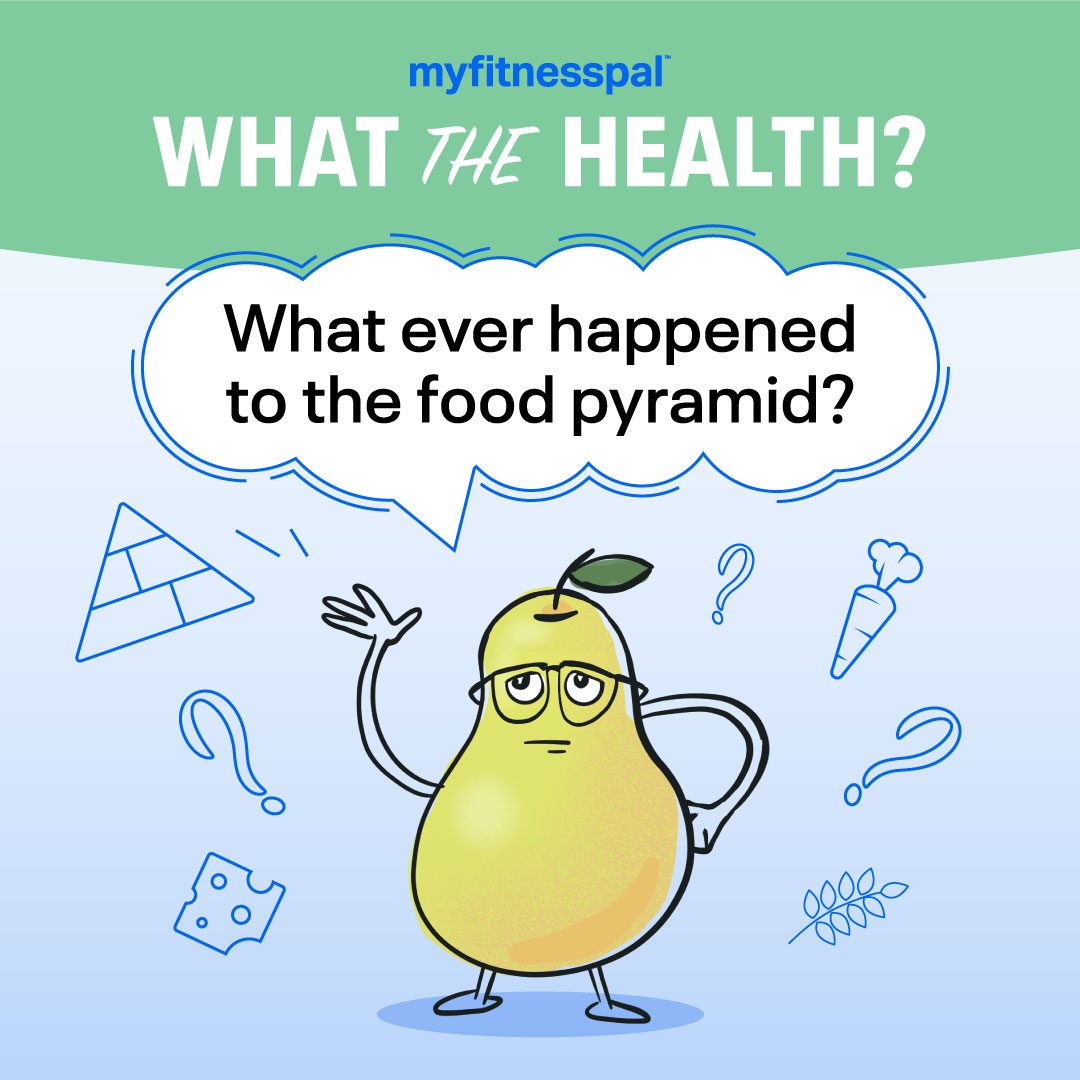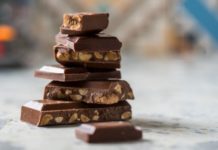
What Ever Happened to the Food Pyramid?

The USDA debuted the Food Guide Pyramid in 1992, giving millions of Americans a visual representation of what to eat. The pyramid featured grains as its base, suggesting 6–11 servings per day. Moving from the bottom to the top, it displayed fruits and vegetables, then protein and dairy, while fats, oils and sweets comprised the tip of the pyramid, with a suggestion to “use sparingly.”
The food pyramid was updated in 2005 to depict vertical slices, rather than stacked categories. And it was officially retired in 2011, replaced with MyPlate, a new guideline represented by a plate sectioned into vegetables, proteins, fruits, grains and dairy. This new guide was meant to be easier for consumers to understand: Simply fill your plate like the graphic suggests, and you’re on the way to a healthy meal.
Below, five experts share their thoughts on the Food Pyramid, MyPlate and how we should be eating today.
WHAT THE PYRAMID GOT RIGHT
Though it’s no longer the preferred recommendation, the pyramid did some good. “The Food Guide Pyramid did provide education as to what should be foundational components to the diet, like whole grains, fruits and vegetables,” says Amy Goodson, RD, MS. It also taught us about eating varied food groups.
“Something accurately depicted in the Food Pyramid is that all food fits into a healthy eating pattern,” says Liz Wyosnick, MS, RD, owner of Equilibriyum, a private nutrition practice in Seattle. “It’s just a matter of consuming foods in appropriate proportions.” For example, the pyramid placed high-sugar items at the very top, expressing that these foods should be the smallest part of your overall intake. Fresh produce and whole grains made up the largest portions, representing the significant role they play in your diet. “If you think about it, there is a lovely metaphor with the food pyramid. The strength and integrity of a pyramid comes from a sturdy and sound base, just as the strength of our health comes from a foundation of nutrition based in fresh, whole vegetables,” adds Wyosnick. She notes that the metaphor of the pyramid may have fallen flat, but it had positive intentions.
WHERE THE FOOD PYRAMID FAILED
“No one eats a meal in the shape of the pyramid,” says Leslie Bonci, RD, MPH, owner of Active Eating Advice. “The concepts were complicated and hard to visualize, and some people read it top down instead of bottom up.” She also notes that the pyramid recommendations were one-size-fits-all, when individual dietary needs vary. “Six to 11 grain servings per day doesn’t mean 11 for everyone.”
In 1992, when the Food Guide Pyramid was first released, the country was in the midst of a no-fat/low-fat craze. “A major flaw of the pyramid was the vague recommendations to use all fats ‘sparingly,’” says Melissa Macher, RD, LD, owner of A Grateful Meal. No exceptions were given for nuts, avocados or fish loaded with omega-3 fatty acids — foods we know to contain healthy fats. “There was also no obvious distinction regarding fiber-rich, complex carbohydrates versus simple carbohydrates,” adds Macher. The simplified pyramid did not allow for important distinctions, so the public message and overall efficacy were diluted.
“Science has shown that when people limit their fat intake — including their intake of healthy fat — and eat a heavy carbohydrate diet, which is the pattern promoted by the Food Pyramid, they tend to have unhealthy cholesterol and triglyceride levels,” says Samantha Cassetty, MS, RD, a nutrition and wellness expert and co-author of Sugar Shock. This way of eating can promote heart disease and it unfavorably influences your bad and good cholesterol levels. “We know a lot more about foods and eating patterns that are associated with better health outcomes, and we’ve clarified a lot of the advice that was depicted in the Food Pyramid.”
The Food Pyramid also lacked clarity. For instance, Cassetty notes the protein recommendations were considered maximums, while the vegetable targets were minimums. Unless they closely parsed the details, consumers were likely to miss this discrepancy. And while the guidelines were not necessarily unhealthy, Wyosnick contends that they were unintuitive and difficult to utilize to accurately guide food decisions at the consumer level.
The pyramid did get people thinking more about food, which can be beneficial overall. But the core tenets of the pyramid naturally pitted one category against another.
“In my opinion, the stacking of the food groups, particularly in the 1992 version, reinforced a binary of ‘good’ versus ‘bad’ food, which certainly didn’t help Americans’ relationship with food,” says Macher. Instead, it cemented a moral attachment to certain foods.
MOVING TO MYPLATE
It’s natural that dietary recommendations — just like medical advice — aren’t stagnant. “As nutrition science has evolved, the USDA’s dietary guidelines have shifted, and the representations on MyPlate reflect our current understanding of nutrition and health,” says Cassetty.
MyPlate addresses several of the issues from the Food Guide Pyramid. For example, vegetables are given a greater share of the meal than grains, and fats are not relegated to a tiny sliver at the top — instead, dairy is given a place next to the plate to complement meals. Bonci calls it “a more consumer-friendly portrayal for education and implementation.” Though it’s still overly simplified, everyone can understand the plate graphic.
“I really like this depiction because it is so much more relatable and easier to execute on a meal-by-meal basis,” says Wyosnick, who constructs the majority of her meals according to the balanced plate model: 1/2 produce, 1/4 complex carbohydrates and 1/4 protein. “I know that it is supportive on a macronutrient and micronutrient level.”
But MyPlate isn’t perfect. Macher points out criticisms that the food industry had too much input in MyPlate’s development, and notably, its recommendations still don’t fully address the nuances of dietary fat. She recommends an alternative: Harvard’s Healthy Eating Plate, which gives more context than MyPlate and also includes water consumption and physical activity as part of its visuals.
“Personally, I like using a plate visual as a teaching tool, but I prefer to give much more individualized recommendations to my clients based on their preferences and history,” she says. “The nuance of food and nutrition from a scientific and cultural standpoint is difficult to distill in a one-size-fits-all plan. The plate method is a decent place to start, but seeking out the assistance of professionals that can take not just your physical health, but also your mental and emotional health, preferences, and cultural practices into account is really where we can find the most sustainable solutions.”
THE BOTTOM LINE
The Food Guide Pyramid was well-intentioned, but it’s not the preferred eating plan today. MyPlate gets you closer to a balanced diet, but regardless of whether you put your faith in plates, pyramids or something else entirely, there are several agreed-upon practices for healthy eating. In general, it’s best to focus on fresh produce, supplemented with lean proteins, whole grains, dairy and healthy fats. Eat from all food groups to ensure a sound diet.
“Remember that these are goals, but don’t feel overwhelmed or defeated if your eating habits are nowhere close to them,” says Cassetty. “You can take small steps to improve your diet. For example, set a goal to snack on fruit and nuts instead of a packaged snack, or replace a sugary drink with water.” You don’t have to eat healthy all the time, and everyone deserves to eat the foods they enjoy and treat themselves on occasion. “But even small steps toward creating healthier eating habits mean you’re heading in the right direction.”





